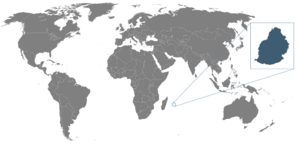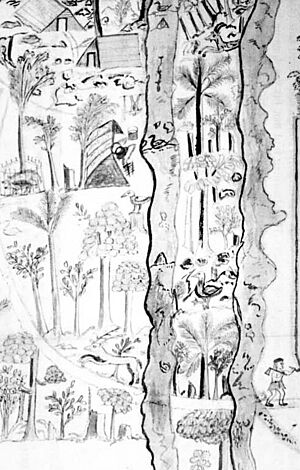Mauritius sheldgoose facts for kids
Quick facts for kids Mauritius sheldgoose |
|
|---|---|
 |
|
| 1893 illustrations of the first known carpometacarpus wing-bone | |
| Conservation status | |
| Scientific classification | |
| Genus: |
Alopochen
|
| Species: |
mauritiana
|
 |
|
| Location of Mauritius | |
| Synonyms | |
|
|
The Mauritius sheldgoose (Alopochen mauritiana) was a type of goose that lived only on the island of Mauritius. Sadly, it is now extinct. People visiting Mauritius in the 1600s wrote about geese there. However, they didn't give many details.
In 1893, scientists found some bones from a swamp. These bones helped them name a new species. They later realized these bones belonged to a bird related to the Egyptian goose. This bird was then placed in the sheldgoose genus Alopochen. The Mauritius sheldgoose and the Réunion sheldgoose might have come from Egyptian geese. These geese probably flew to the Mascarene islands a long time ago.
One old description says the Mauritius sheldgoose had wings that were half black and half white. It was also said to be not very large. Fossils show it was smaller than the Egyptian goose. But it had stronger, more powerful legs. Not much is known about its daily life. But old stories say it was very tame. It ate grass and lived in groups. These geese usually stayed on the north side of the island. They only moved to other areas during dry seasons to find water. Their strong legs suggest they spent more time on land. This matches stories that they avoided water.
Travelers thought the bird tasted very good. In 1681, there were many of them. But their numbers quickly dropped. By 1698, they were declared extinct. The Mauritius sheldgoose likely disappeared because of too much hunting. Also, new animals brought to the island, especially cats, probably ate their eggs and young.
Contents
Discovering the Mauritius Sheldgoose
People visiting Mauritius in the 1600s saw geese. But they didn't write much about them. In 1889, the government of Mauritius asked for a search. They wanted to find "historical souvenirs" in the Mare aux Songes swamp. Many dodo bones had been found there before.
New searches found more bones. These included bones from other extinct animals. Some were known, and some were new species. These bones were sent to the Cambridge University Museum of Zoology. There, two scientists, Edward Newton and Hans Gadow, studied them. They found a left wing-bone called a carpometacarpus. This bone was from a large bird. They thought it was a new species of comb duck. They named it Sarcidiornis mauritianus. They also believed a part of a pelvis bone belonged to this same bird.
Over the years, scientists debated where this bird fit. Some thought it wasn't a comb duck. In 1987, a scientist named Graham S. Cowles found another wing-bone. This bone helped confirm that the Mauritius bird was not a comb duck. Instead, it belonged to the sheldgoose group, Alopochen. This is the same group as the living Egyptian goose.

Scientists now agree that the Mauritius sheldgoose belongs in the Alopochen genus. It is closely related to the Egyptian goose. It is also related to the Malagasy sheldgoose and the Réunion sheldgoose. These island geese likely came from Egyptian geese. They probably flew from Africa to the Mascarene islands. Fossils of the Mauritius sheldgoose are very rare. In 2006, a lower leg bone (tarsometatarsus) was found. Another forelimb bone (radius) was also identified as belonging to this goose.
The Mauritius sheldgoose has had other names. These include Mauritius shelduck and Mascarene swan.
What the Mauritius Sheldgoose Looked Like
The best description of the Mauritius sheldgoose comes from an English traveler, John Marshall, in 1668. He wrote: "Here are many geese, the halfe of their wings towards the end, are black, and the other halfe white. They are not large but fat and good [to eat]."
The main wing-bone (carpometacarpus) found was about 77 millimeters (3 inches) long. This is similar in size to the Malagasy sheldgoose. It was a bit bigger than the Réunion sheldgoose. It was also about the same size as a brant goose. But it was much smaller than a domestic goose. There is no proof that the Mauritius sheldgoose could not fly.
Other fossil bones show it was smaller than the Egyptian goose. But its legs were stronger. This is a feature it shared with the Réunion sheldgoose. The pelvis bone was about 70 millimeters (2.7 inches) long. This is similar to the brant goose. We don't know what its bill looked like. But the Réunion sheldgoose had a shorter bill than the Egyptian goose.
A Possible Drawing
In 2004, a scientist named Anthony S. Cheke tried to identify a bird in an old drawing. This drawing showed a farm in Foul Bay, Mauritius, around 1670. It showed farm life, animals, and birds. Some historians thought the bird was a dodo. They believed it was the last drawing of a living dodo.
However, Cheke found no evidence that it was a dodo. The bird in the drawing had a short, deep bill and webbed feet. It also had normal wings and a short, upturned tail. These features do not match a dodo. Cheke suggested it was actually a Mauritius sheldgoose. If true, this would be the only known drawing of this bird while it was alive. This new idea also meant the dodo might have been extinct before 1670.
Behaviour and Ecology
We don't know much about how the Mauritius sheldgoose lived. A Dutch soldier, Johannes Pretorius, wrote about them in the 1660s. He said: "Geese are also here in abundance. They are a little larger than ducks, very tame and stupid, seldom in the water, eating grass, sometimes 40 or 50 or even a 100 together. When they are being shot, the ones that are not hit by the hail stay put and do not fly away. They usually keep to the north side of the island, far away from where the people live, except in the dry season when they are forced to drink on the other side of the island, and sometimes near the lodge."

Like many geese, the Mauritius sheldgoose ate grass. Mauritius once had many types of native grasses. Some of these are now extinct. The strong legs of the Mauritius sheldgoose suggest it spent more time on land. A ship's log from 1681 also supports this. It said geese were mostly found in the woods or dry ponds.
Many other native animals and plants on Mauritius disappeared after humans arrived. The island's natural environment is now very damaged. Most of the forests have been cut down. The animals that are still alive are in danger. The Mauritius sheldgoose lived with other extinct Mauritian birds. These included the dodo, the red rail, and the Mascarene teal. Extinct reptiles like giant tortoises also lived there.
Extinction of the Mauritius Sheldgoose
Travelers to Mauritius often wrote about how good the geese and ducks tasted. Hunters on the island liked to hunt them. In 1681, there were many Mauritius sheldgeese. But their numbers quickly went down. By 1693, a French explorer thought they were rare. In 1698, the Dutch governor of Mauritius said they were extinct.
Scientists believe that hunting played a part in their disappearance. But the main reason was probably new animals brought to the island. These animals, especially cats, likely ate the geese's eggs and chicks. Rats and pigs were also introduced, but the geese seemed to survive them.
|



